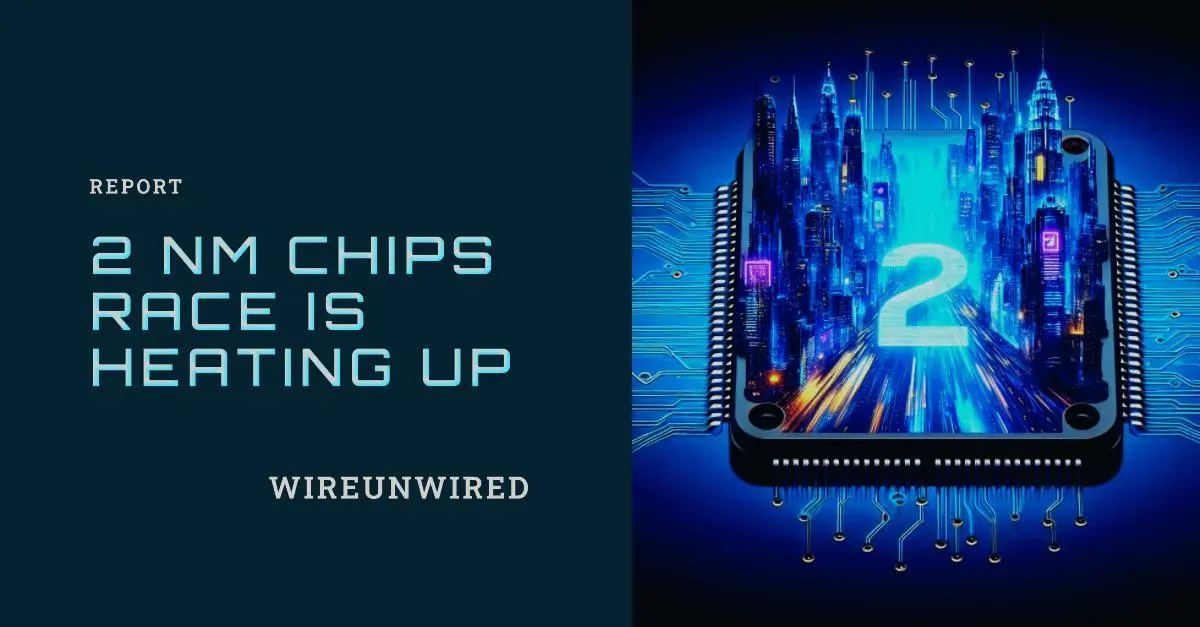The semiconductor manufacturing industry has flourished a lot in recent years , thanks to researchers working constantly to improve the technology behind these semiconductor chips.
One of the areas where researchers have put a lot of effort into maintaining Moore’s Law is reducing the node size. Just a few years ago, we had chipsets with 14 nm based nodes, and now we are in a race to 2 nm chips with 3 nm chips already going into mass production.
As the semiconductor industry is racing towards the next big leap in technology, the development of 2 nm chips stands at the forefront of innovation.
There are too many hopes with these new 2 nm chips, including increased power efficiency , further enhanced raw power, and density. In this article, we will try to understand why every other company is in the race to make 2 nm chips, what the potential challenges are, and who the key players are in the race to 2 nm chips. We will also explore the potential impact of 2 nm chips on the technology industry as a whole.
Table of Contents
ToggleWhat Are 2nm Chips and Why Are They Important?
2 nm chips represent the latest milestone in semiconductor manufacturing, significantly smaller and more efficient than their predecessors. The term “2nm” refers to the process node technology used to create these chips, which allows for more transistors to be packed into a smaller space.
As the semiconductor industry faces hurdles in following Moore’s Law 2 nm is like a ray of hope. This packing of more transistors in the same space as compared to predecessor node sizes results in chips that are faster, more energy-efficient, and capable of handling more complex computations. For example, IBM’s 2nm chip can fit up to 50 billion transistors on a chip the size of a fingernail, quadrupling the battery life of smartphones and significantly reducing data centre energy consumption (IBM Research) (ServerWatch).
Also Read : Top 5 semiconductor trends in 2024.
Key Players in the Race to Develop 2 nm Chips
Several major companies are leading the charge in the development of 2 nm chips:
1) IBM: IBM has been a pioneer in nanosheet technology, which is critical for 2 nm chips. Their 2 nm transistors use a stack of ultrathin nanosheets to enhance performance and power efficiency. IBM’s innovations promise significant improvements in AI, cloud computing, and security applications (IBM Research) (ServerWatch).
2) TSMC (Taiwan Semiconductor Manufacturing Company): TSMC is on track to start mass production of its 2 nm chips by 2025. Their N2 technology aims to deliver a 15-20% improvement in frequency, a 30-40% reduction in power consumption, and a significant increase in chip density compared to their current 3nm technology (AnandTech).
3) Samsung: Samsung has already cracked a deal with Preferred Networks Inc. (PFN), a leading Japanese AI startup, to produce 2nm AI chips . Experts believe that Samsung’s 2nm process technology will try to challenge TSMC’s dominance in the semiconductor market by offering lower prices and comprehensive manufacturing capabilities (TechHQ).
4) Intel: Intel is also trying to make a comeback with its 2nm (20A) and 1.8nm (18A) technologies, aiming to provide these advanced chips to a broad range of customers. Intel’s focus is on overcoming past production challenges and positioning itself as a competitive force in the advanced semiconductor market (Tom’s Hardware).
Technological Challenges and Advancements
The transition to 2nm technology involves overcoming several significant challenges:
1) Miniaturization: Achieving smaller transistor sizes while maintaining performance and reducing power consumption is a complex task. Innovations such as IBM’s nanosheet transistors and TSMC’s backside power delivery are crucial for this leap (IBM Research) (AnandTech).
2) Manufacturing Precision: Extreme Ultraviolet (EUV) lithography is essential for the precise patterning required at the 2nm scale. IBM and other leaders have developed advanced EUV techniques to meet these demands (IBM Research).
3) Integration and Scalability: Ensuring that new 2nm chips can be integrated into existing systems and scaled up for mass production without significant yield losses remains a critical focus area for all players (ServerWatch) (Tom’s Hardware).
Impact on Industries and Everyday Technology
The introduction of 2 nm chips will revolutionize various industries:
1) Consumer Electronics: Enhanced battery life and processing power in smartphones, laptops, and wearable devices will provide a superior user experience (IBM Research) (ServerWatch).
2) Data Centers: Significant reductions in energy consumption will lead to more sustainable and cost-effective data center operations (ServerWatch).
3) AI and Machine Learning: Increased computational power will enable more sophisticated AI applications and faster data processing (TechHQ) (ServerWatch).
Expected Timeline for Development and Commercialization
The race to 2 nm is intensifying, with different companies setting ambitious timelines:
- IBM : Plans to integrate 2nm technology into its server processors and mainframes by 2024 (ServerWatch).
- TSMC: Mass production of 2nm chips is slated to begin in 2025, with broader availability expected in 2026 (AnandTech).
- Samsung : Expected to start mass production of 2nm chips for mobile applications in 2025 and expand to high-performance computing applications by 2026 (TechHQ).
- Intel : Aiming to introduce its 2nm chips in 2024, with a focus on overcoming past manufacturing hurdles and scaling up production (Tom’s Hardware).
Join our WhatsApp community.
Conclusion
The race to 2 nm chips is more than just a technological competition; it’s a pivotal moment for the entire semiconductor industry. As IBM, TSMC, Samsung, and Intel push the boundaries of what’s possible, the benefits will ripple across all sectors, from consumer electronics to advanced computing. This relentless pursuit of innovation not only promises to enhance our digital lives but also underscores the critical role of semiconductors in shaping the future.
By staying at the forefront of these advancements, wireunwired.com aims to keep you informed about the latest developments and their implications. Stay tuned as we continue to cover this exciting journey into the next generation of semiconductor technology.
Discover more from WireUnwired
Subscribe to get the latest posts sent to your email.





